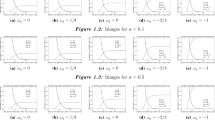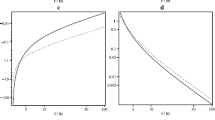Abstract
The structure of stationary, axisymmetric advection-dominated accretion disk (ADAF) around rotating black hole, using non-standard model, was examined. In this model, the transport efficiency of the angular momentum \(\alpha \) was dependent on the magnetic Prandtl number \(\alpha \propto \mathit{Pm}^{\delta } \). The full relativistic shear stress recently obtained by a new manner, was used. By considering black hole spin and Prandtl number instantaneously, the structure of ADAFs was changed in inner and outer region of the disk. It was discovered that the accretion flow was denser and hotter in the inner region, due to the black hole spin, and in the outer region, due to the presence of Prandtl parameter. Inasmuch as the rotation of the black hole affected the transport efficiency of angular momentum in parts of the disk very close to the even horizon, then in these regions, the viscosity depended on the rotation of black hole. Also, it was discovered that the effect of the black hole spin on the structure of the disk was related to the presence of Prandtl parameter.





Similar content being viewed by others
References
Abramowicz, M.A., Chen, X., Granath, M., Lasota, J.-P.: Astrophys. J. 471, 762 (1996)
Balbus, S.A., Hawley, J.F.: Rev. Mod. Phys. 70, 1 (1998)
Chakrabarti, S.: Astrophys. J. 471, 237 (1996)
Fromang, S., Papaloizou, J., Lesur, G., Heinemann, T.: Astron. Astrophys. 476, 1123 (2007)
Gammie, C.F., Popham, R.: Astrophys. J. 498, 313–326 (1998)
Hameury, J.-M., Lasota, J.-P., McClintock, J.E., Narayan, R.: Astrophys. J. 489, 234 (1977)
Kato, S., Fukue, J., Mineshige, S.: In: Black Hole Accretion Disks: Towards a New Paradigm, pp. 166–175. Kyoto University Press, Kyoto (2008)
Khesali, A., Salahshoor, K.: Astrophys. Space Sci. 359, 21 (2015)
Lasota, J.-P.: In: Duschl, W.J., Frank, J., Meyer, F., Meyer-Hofmeister, E., Tscharnuter, W.M. (eds.) Theory of Accretion Disks, vol. 2, p. 341. Kluwer, Dordrecht (1994)
Lasota, J.-P., Abramowicz, M.A., Chen, X., Krolik, J., Narayan, R., Yi, I.: Astrophys. J. 462, 142 (1996a)
Lasota, J.-P., Narayan, R., Yi, I.: Astron. Astrophys. 314, 813 (1996b)
Lesur, G., Longaretti, P.-Y.: Mon. Not. R. Astron. Soc. 378, 1471 (2007)
Longaretti, Lesur, G.: Astron. Astrophys. 516, A51 (2010)
Lynden-Bell, D., Pringle, J.E.: Mon. Not. R. Astron. Soc. 168, 603 (1974)
Mahadevan, R.: Nature 394, 651 (1998)
Manmoto, T.: Astrophys. J. 534, 734 (2000)
Manmoto, T., Mineshige, S., Kusunose, M.: Astrophys. J. 489, 791 (1997)
Misner, C.W., Thorne, K.S., Wheeler, J.A.: Gravitation. Freeman, San Francisco (1973)
Moeen, M.: Publ. Astron. Soc. Jpn. 64, 137M (2012)
Narayan, R., Mahadevan, R.: Nature 373, 623 (1995)
Narayan, R., Yi, I.: Astrophys. J. 428, L13 (1994)
Narayan, R., McClintock, J.E., Yi: Astrophys. J. 457, 821 (1996)
Narayan, R., Mahadevan, R., Grindlay, J.E., Popham, R.G., Gammie, C.: Astrophys. J. 492, 554 (1998)
Novikov, I.D., Thorne, K.S.: In: De Witt, C., De Witt, B.S. (eds.) Black Holes, vol. 343. Gordon and Breach, New York (1973)
Peitz, J.: Ph.D. thesis, Univ, Heidelberg (1994)
Peitz, J., Appl, S.: Mon. Not. R. Astron. Soc. 286, 681 (1997)
Popham, R., Gmmie, C.F.: Astrophys. J. 504, 419 (1998)
Potter, W.J., Bulbus, S.A.: Mon. Not. R. Astron. Soc. 441, 681 (2014)
Shakura, N.I., Sunyaev, R.A.: Astron. Astrophys. 24, 337(SS73) (1973)
Simon, J.B., Hawley, J.F.: Astrophys. J. 707, 833 (2009)
Spitzer, L.: Physics of Fully Ionized Gases. Interscience, New York (1962)
Takahashi, R.: Astron. Astrophys. 461, 393 (2007)
Takahashi, H.R., Masada, Y.: Astrophys. J. 227, 106 (2007)
Yuan, F., Quataert, E., Narayan, R.: Astrophys. J. 598, 301 (2003)
Author information
Authors and Affiliations
Corresponding author
Appendix
Appendix
In the text, \(f_{n}(V)\), \(f_{n}(\rho )\) and \(f_{n}(l)\) were expressed in terms of \(V\), \(\rho \) and \(l\).
(i) In (38) and (39) we use \(f_{n}(V)\) as following:
(ii) In (41) and (42), \(f_{n}(\rho )\) was written as
(iii) We have replaced in (44) and (45) \(f_{n}(l)\) as
Rights and permissions
About this article
Cite this article
Khesali, A.R., Salahshoor, K. Structure of relativistic accretion disk with non-standard model. Astrophys Space Sci 361, 243 (2016). https://doi.org/10.1007/s10509-016-2804-2
Received:
Accepted:
Published:
DOI: https://doi.org/10.1007/s10509-016-2804-2




